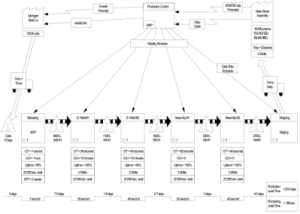Value Stream Mapping (VSM for short) is a term heard more and more frequently these days, particularly in business improvement. Those who have been involved in business improvement for a while however will be able to tell stories about seeing magnificent maps with multiple steps, a rainbow of coloured notes and a huge amount of data, created enthusiastically and displayed with pride by their creators. When asked what has been done as a result of all the work to improve the organisation, the answer sadly is little or nothing.
So what is VSM, why the interest in it, and why the apparent problems with little work being done as a result of the activity?
We can define value as anything the customer is prepared to pay for. If there is no paying customer, then this can be redefined as anything that increases the form or function of a product or service. A Value Stream is the series of events that take a product or service from its beginning through to the customer, and the value stream map is a diagrammatic representation of that series of events showing the main physical features.
The reason for the current interest is that most organisations recognise the importance of customers, and delivering value, and recognise that they need to understand how they do this.
The reason why little is done is because practitioners don’t realize that the value stream map is primarily a method for communicating current and potentially improved process performance, and don’t understand the steps involved in creating a clear and simple representation of the value stream.
A value stream map is defined in Wikipedia as “a lean-management method for analysing the current state and designing a future state for the series of events that take a product or service from its beginning through to the customer”. This definition gives us a clue about the purpose of VSM, the definition of the future state is the crucial aspect. The Value Stream Map is a means to an end, its purpose is to help create a more efficient and effective organisation.
Stephen Covey, in The 7 habits of highly effective people, quotes habit 2 as “begin with the end in mind”. We should adopt the same approach with Value Stream Mapping, before starting, decide why we are doing it, who the map will be shown to and how to present it in a way that can be easily understood. VSM is different to process mapping, process mapping is about understanding a process at a detailed level. Value Stream Mapping is about understanding a Value Stream at a high level to uncover opportunities for improvement.
Value Stream Mapping also links material and information flow and includes critical process data to make waste visible and summarizes actual lead times and process times. It is also a great way to establish a common language amongst those with an interest in understanding the value stream. The most important reason for using it is it exposes opportunities for waste elimination and variation reduction events and projects.
Having established why we should carry out Value Stream Mapping, who it is for and its true purpose, what are the steps involved to make sure it is a useful activity and leads to improvement?
In our view there are eight key steps to build an effective Value Stream Map:
- Select and scope the value stream
- Identify the major process steps
- Collect customer data
- Collect process performance data
- Update the VSM with the process data
- Record stock information
- Show information and material flow
- Calculate lead and process times and PCE and finalise the map
Business & Finance Articles on Business 2 Community
(78)
Report Post








